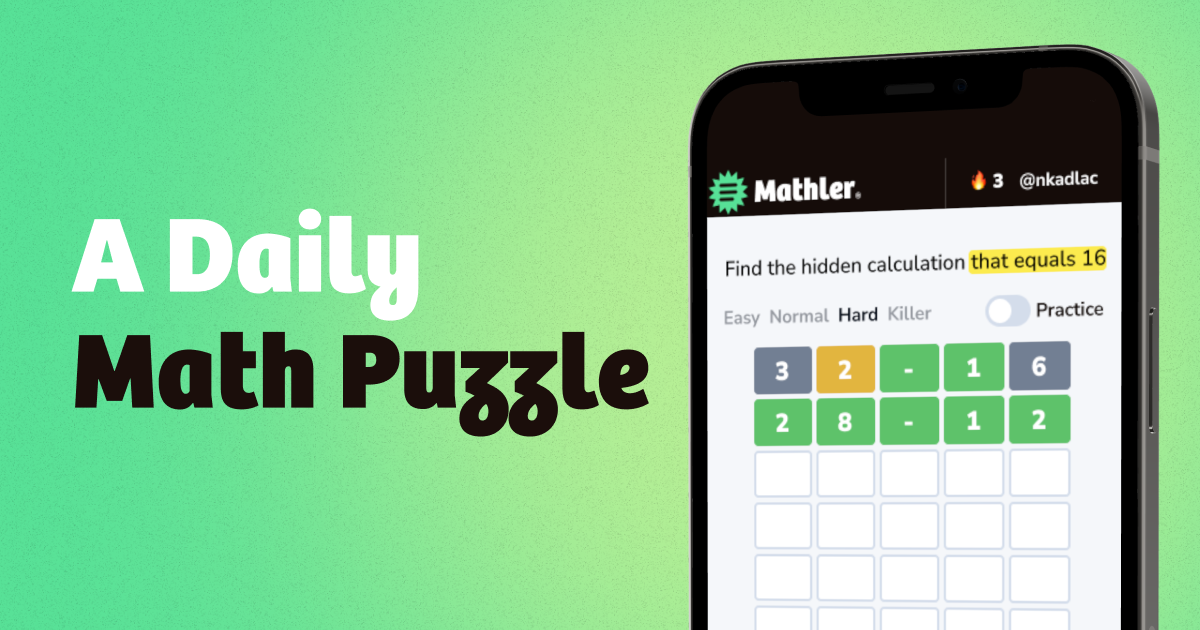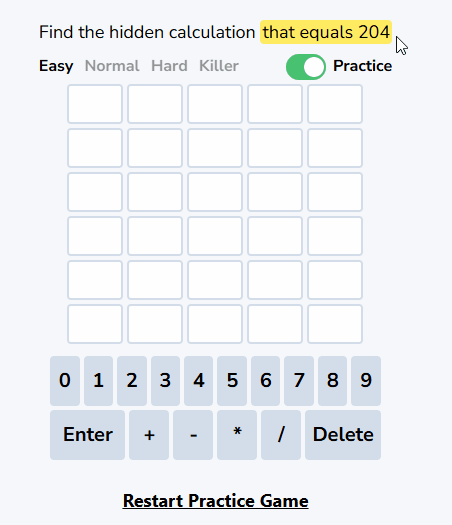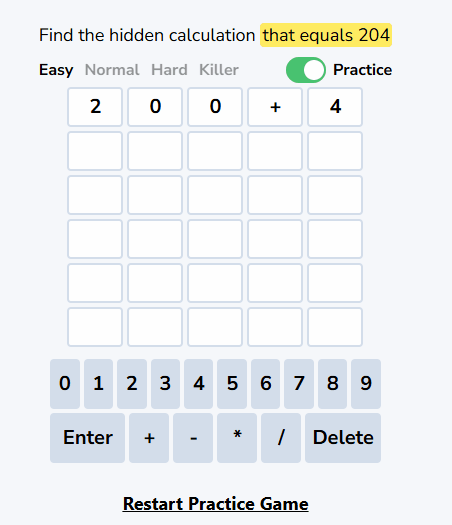Daily Math Puzzle: Play, Learn and Improve Mental Math

Daily games have taken the world by storm ever since its subgenre started to fully form during the COVID-19 pandemic. While word puzzles and classic games took the center stage, there are many other flavors of daily games that hooked people hard and continue to do so today.
Mathler is an arithmetic-based puzzle game inspired by Wordle®. It's a very fun and refreshing way to learn (or relearn) the core foundations of basic mathematical operations, and you can do it all for free, with no sign-ups and made for the whole family!
How the daily math puzzle works
It is, at its core, a number puzzle game. Your goal is to create a solution that will lead to a certain result. However, unlike sudoku or kakuro, the gameplay revolves around the premise that you already have the answer to the equation. Using that answer or given, you have to guess the right solution with the help of the familiar color-feedback system from Wordle, and you have six tries to get it right.
Playing Mathler: step-by-step
Step 1: Choose Mathler at Hey, Good Game

Go to our website, Hey, Good Game, then scroll down to find Mathler. Click or tap on Mathler to be redirected to the game itself. To make it easier to access, just bookmark the website the moment you arrive!
Step 2: Select your difficulty and mode

To begin playing Mathler, you must first select your preferred difficulty and your mode. Keep in mind that every default game starts you off in Daily mode at Normal difficulty. Mathler currently has the following difficulties available:
To make this guide easier to follow and complete for yourself, we'll start off with Easy difficulty and in Practice mode.
To toggle Practice mode, simply click or tap the sliding button marked "Practice".
Step 3: Check the target number and the rest of the menu

Now, assess your current puzzle and what you have to work with. Different difficulties have different interfaces and boxes; some have fewer, some have more, others don't have certain operations, while others do.
To keep things simple for now, we'll stick to Easy difficulty, with basic operations and five boxes. In this example, the given is 204, and we'll need to think of solutions that will work for it. Here, we'll enter 200+4 as our first guess, and that results in 204.
Step 4: Guess the hidden calculation

You can now start inputting the solutions for the given! We've already entered an initial guess, so press Enter and it'll go in. After that, we're given color feedback based on the status per box:
| Color | Meaning | Example |
|---|---|---|
| Green | Correct character in the correct position | 2 is green in 2+3 if the first slot must be 2 |
| Yellow | Character is in the equation, but in a different position | + is yellow if the plus sign belongs elsewhere |
| Gray | Character is not in the equation | 7 is gray when no 7 appears at all |
But before you start putting in your guesses, it is very important to remember the following:
- Your guesses must result in the given. For example, the given is 10, and you input something like +-*/10, the system will consider it invalid.
- Remember the order of operations, PEMDAS: Parentheses, Exponents, Multiplication, Division, Addition and Subtraction. If you input something you think makes sense but isn't accepted by the system, then you've probably made a mistake in the order. For example, the given is 50, and you input something like 10*4+1. This is invalid because this results in 41, as multiplication comes before addition.
Using the hints given by our first guess, we are then able to hit the correct solution the second time around!
Step 5: Assess and share
After finishing your puzzle, don't forget to assess and learn what you did well (and if you didn't get the answer, scan over your mistakes and improve). Your stats can be shared and saved if you have an account, so if you're interested, sign up today and enjoy solving!
Difficulty levels explained
To give our players more room to choose and enjoy themselves, we deliberately made Mathler have multiple levels of difficulty. Not everyone is a math genius, nor does everybody like an easy equation. This way, anybody can pick whichever level they feel like doing. After all, Mathler is made to be fun, not a chore!
Here are the following levels we currently have on our game:
| Mode | Expression slots | Tries | Parentheses | Operators set | Example pattern |
|---|---|---|---|---|---|
| Easy | 5 | 6 | No | Basic (+, −) | 90+30 |
| Normal / Classic | 6 | 6 | No | Basic (+, −) | 1080/9 |
| Hard | 8 | 6 | Yes | Full (+, −, ×, ÷) | 12×(8−4) |
| Extreme | 6 | 6 | No | Full (+, −, ×, ÷) | 4×3+10 |
Notes: “Expression slots” = number of characters you can place. All modes allow 6 guesses; PEMDAS (order of operations) applies.
Basic strategies to solve faster
There are many different ways you can hit the right solution fast. While solving the puzzle is the main goal, most players want to get it in the least number of tries possible, with getting it in two guesses considered the perfect run.
Here are some of the best general strategies to win when you play Mathler:
Training using Practice mode
Playing continuously using a dedicated mode made for experimentation and learning is key to becoming a skilled Mathler solver. Not everyone is a genius at arithmetic, but everyone can learn to become proficient in it through prolonged solving.
Practice mode enables you to learn without the pressure of messing up your Daily mode streak or existing scores, and helps you learn common patterns in creating the right equations. Remember, Mathler is based on arithmetic—the science of counting. It's a science, no luck involved here, only your skill and your enjoyment!
Pay attention to the color feedback
This is probably the most common yet underutilized mechanic among newcomers. It might be a reflex to keep using numbers that pop up on top of your head, but pay attention to the color-feedback system, as it is essential to reaching the right equation.
Most people who waste their guesses try to keep forcing equations that click with their head the most (e.g., 100-xx, if that didn't work, 100+xx again). But remember, once something is grayed out, it's done. Try another number, mix it up. Even if you're not good at math, you can still use the color-feedback system as your hint and everything else that follows is just elimination.
Attempting the obvious
Sometimes, being direct with your solution is actually the best possible route to solving the puzzle. For example, you're playing an Easy difficulty puzzle that has five boxes to use and with the given 120, what are the most obvious solutions?
- 121-1
- 90+30
- 60+60
Or if it's a Normal difficulty puzzle with six boxes and the same given:
- 100+20
- 1080/9
- 140-20
It might not be the direct solution most of the time, but attempting the obvious not only clears doubt but also guides you down the path of the right solution, as your inputs will have color feedback.
Using odd and even numbers
The average newcomer tends to lean towards numbers that are in the 10s (50, 240, 380, etc.), and that usually constrains them into a sort of "0 trance", where they waste their guesses trying to hit the solution using easy-to-think-of numbers that have zeroes at the end or are divisible by 10. Avoid that problem by paying attention to the color-feedback system and using odd and even numbers.
This is especially useful in the higher difficulties, where there are more boxes to work with and the solutions are littered with odd and even digits (like numbers ending in 3, 5 and 7 being often overlooked).
Parentheses are common in higher difficulties
Aside from mastering the fundamentals of operations (PEMDAS), parentheses are commonplace in higher difficulties, especially Hard and Extreme. In your first guesses in these levels, always try to add parentheses whenever possible. Even if the actual solution doesn't have them, eliminating them early clears the way very well and allows you to start eliminating possibilities fast.
Open with a guess that has a wide spread
This opening tactic is basically the same as using "OUIJA" in Wordle—you try to use and eliminate as many of the digits and operations as you possibly can from the get-go. For example, you're playing an Extreme difficulty puzzle with a given of 12, you can open up with a 4-5+13. That's already four out of ten possible numbers, and uses two out of four operations for that difficulty.
Other math-based Wordle variants
Mathler isn't alone in providing a great time with numbers! Here are the following games we recommend you try out if you enjoy playing Mathler:
Sumplete
A number logic puzzle game created in collaboration with AI, this game is inspired by sudoku, kakuro and hitori. Just like in Mathler, you already have a given in the puzzle, but in this case, they're all "sum clues" and the challenge is choosing the right numbers to add up horizontally and vertically.
- Grid-based
- A wide variety of difficulties and grid sizes to choose from
- Daily/Unlimited mode
Nerdle
Nerdle is very similar to how Mathler works. The main difference is that there's no given, and you have to create the whole equation and result within the constraints of the puzzle. This game was also featured to be one of Bill Gates's preferred daily games.
- Box-based
- A "Nerdleverse" of difficulties and modes to choose from
- Daily/Unlimited/Custom mode
KenKen
A classic number puzzle, it shares many aspects of sudoku but with more emphasis on arithmetic logic. You have to fill up a grid with a set of numbers (usually from 1-9) without repeating them per row and column. Will Shortz, the NYT's legendary puzzle editor, got addicted when he first got his hands on its prototypes. You can learn more about that here.
- Grid-based
- Highly customizable puzzle settings and preferences
- Daily/Unlimited/Custom mode
FAQ
What time does the daily puzzle reset?
The Daily mode usually refreshes around 12:00 PM EST.
Can numbers repeat? Can operators repeat?
Yes and yes. There can be equations like 2+2+2 or 2*2*2, but it usually depends on what difficulty you're playing on. You'll know how many repetitions of a number there is depending on the color feedback.
Do negatives/decimals appear?
No. There are no negative givens and decimals, but there are instances where negatives are needed to arrive at the answer.
Does order of operations (PEMDAS) matter?
Very much so. There are many scenarios where players bump into our error prompt because they get confused with the order of operations.
How many guesses do I get?
Six. You get six guesses per puzzle on any difficulty and mode.
Is there a hard mode/extreme mode?
Yes! They are the go-to difficulties of the more experienced Mathler solvers.
How are equations generated?
We can't get into specifics, but we use algorithms to generate all our puzzles.
How do I share results?
You can share and save your results if you have an account with us. Register here.
Is there a printable version for classrooms?
Yes, we do! Mathler is highly rewarding especially when used in an educational setting. You can click this link for it.
Play Mathler today and improve your math skills!
We hope that our brief guide was able to provide you with the info you need about Mathler. If you enjoy playing brainy puzzles and content like this one, check out our website today and join our official Discord server!